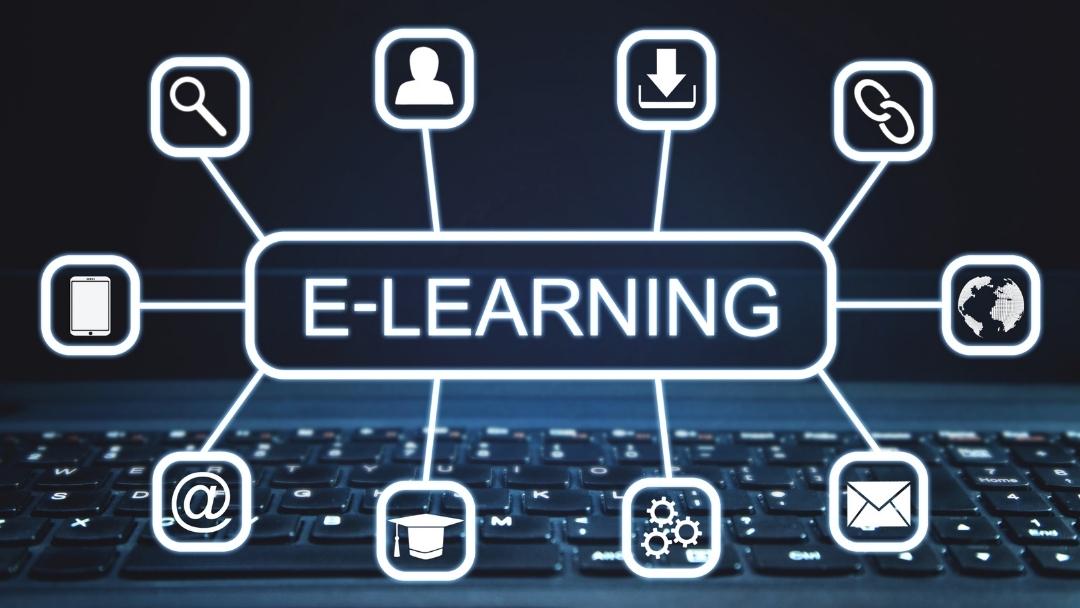The benefits of e-learning

Table of contents
From traditional correspondence courses to comprehensive digital training, distance learning has come a long way and has now reached its peak as e-learning. Today it is no longer a novelty, but a growth industry - the benefits of e-learning are countless. According to statistics, the global e-learning market will continue to grow by 5% per year to $240 Billion in 2022, and in time will replace offline formats.E-learning continues to gain ground in the business sector. Companies implement it to train their employees, streamline their processes, and extend their reach.
What does e-learning mean
So what is e-learning in a real context and why is it so attractive? Let's take a look.Today, when people talk about "e-learning," they are referring to training on any digital device. Watching an educational video, reading an interesting article, or taking a quiz-all these are e-learning.Comparing e-learning with traditional education methods is like comparing e-book formats with paper books. Just as digital texts cannot replace the authenticity of a real book, e-learning cannot replace large-scale education. However, it is always available to you on-demand as long as you have your digital device with you, and thus becomes more convenient.Convenience is one of the main reasons why people love e-learning. Another reason is that you can personalize your learning experience with other new features, such as augmented reality and virtual reality (people love new technology!). For example, with VR courses, warehouse and construction site workers get safety training, and medical students learn how to locate bones and blood vessels. We use e-learning daily to develop ourselves as individuals. We read articles, watch YouTube videos, and play games on our smartphones to exercise our minds. Companies, from small startups to large corporations, also use e-learning to train employees and help with internal processes. But wouldn't you like to know how it all began?
The history of e-learning
The term e-learning was coined by US learning guru Elliott Masie in November 1999, when he gave his speech at the TechLearn Conference: "e-learning is the use of network technology to design, deliver, select, manage, and extend learning."In 2000, e-learning was revolutionized as a technology with the release of OLAT, the first open source learning management system. That year also saw the release of the first version of SCORM, a standard that allows users to "package" content and distribute it within an LMS.In the early 2000s, mobile devices became increasingly common and took the form of smartphones and tablets. They were no longer just used for making calls: people watched videos, read books, and played games on their cell phones. This prompted cell phone companies to improve mobile connectivity, a race that continues today.Mobile devices are now a popular option for accessing e-learning, both for businesses and for education in general.
What are the benefits of e-learning for companies?

There are countless benefits of e-learning for companies because it offers:
Lower training costs
With e-learning, you don't have to spend a fortune holding seminars, booking hotel rooms, and covering travel expenses. You can simply develop an online course and share it with your employees.
Wider coverage
Distance learning has no barriers. You can train hundreds of employees in dozens of offices around the world in a uniform manner. Employees don't need to spend time attending classes in a classroom. All they need is a digital device and Internet access.
Single knowledge base
All learning material is stored in one place, that is, in one Learning Management System (LMS). Employees can access the LMS at a convenient time from any device, find the course they need, and refresh their memory.
Faster employee development
Traditional training can be quite slow because it depends on the work schedule of corporate trainers. An LMS is available at any time, allowing your employees to study whenever they want: on the go, during lunch, or at home.
Easy progress tracking
Your business instructors don't need to conduct classroom training and review all material in person. Most LMSs have analytics that show each student's progress in graphs and reports.
Enterprise adaptability
E-learning helps employees keep pace with the company and solve problems in real time. Need to present a new product to your sales team? Create a course and deliver it instantly to thousands of employees.
Companies use the benefits of e-learning to help with the following:
Employee training. This is the main reason why companies implement e-learning. Digital courses are most effective in training employees because they provide a continuous, user-friendly learning solution. Compliance training. Compliance training is mandatory for almost any company. The goal is to inform new employees about company policies. For example, those involving safety and personal conduct. Compliance training is much easier to accomplish with an LMS, especially if you need to implement immediate changes to your policy.Employee engagement. E-learning engages employees with interactive courses, creative design, and game-like elements. The latter specifically aims to keep learner's interest at a maximum with prizes and rankings.Retention of new hires. The onboarding process for new team members can be bewildering, especially if you have a large company. You can make things easier by introducing the company and its key figures step-by-step with digital courses.This will also free-up time for your HR team.Customer and partner development. With digital courses, you can teach your partners and customers about what you do, whether it's about products or services. People like innovation, but are often suspicious of things they don't know. Use courses and presentations to explain how your service works and why it is good. This will make them feel safe and integrate them faster.Product promotion. Brands and retail companies always have new products to present. You can use e-learning to teach your sales teams about new additions and help new employees learn about the products faster. As a result, you get more sales.So how exactly do companies achieve these goals with e-learning? A quality digital course is more than just a sequence of slides. The content you present needs to be engaging, informative, and interactive.Read also: Best Elearning Platforms available on the market
7 More benefits of E-learning

1. Complete flexibility
Unlike a traditional school, or training institute, which has its set training schedules that students or trainees must follow (where you may even need to dedicate an entire day), e-learning offers flexibility by dividing the course into small blocks that can fit into your daily schedule or by allowing you to select a time when you want to study completely. Therefore, you can complete the course easily without any stress, ...'
2. Study wherever you like
Since e-learning uses video conferencing software like ezTalks to train you, you do not need to visit any classrooms, and instead can complete the training not only using your PC, but also laptops, smartphones or tablets. This allows you to complete your training even on the road. Since you can study while traveling, you can make the most of your travel time.
3. Save travel costs
Since e-learning does not require you to visit any institute, you will not have to incur travel costs, or transportation costs to and from the institute. Often, schools or training centers may be located in remote areas. To travel to such distances you will have to incur a lot of expenses and a lot of time will be wasted.Fortunately e-learning helps you save time and cost for such expenses.
4. You don't follow that for all methods
In traditional training schools, there is a specific curriculum or training material that is meant for everyone, and everyone needs to follow and complete it within the scheduled time. However, e-learning does not follow that method for everyone. Most times, there is a quick knowledge quiz.Therefore, if you already have this knowledge and pass the quick quiz, thenyou are allowed to skip that area and focus on the areas that you still need to learn.
5. Less expensive
Since no room or instructor time is used, e-learning proves to be a much cheaper option. If you already have a device with which the training can be done, you will be saving even more. Therefore, for companies on a tight budget, e-learning can be extremely beneficial.
6. Global benefit
With almost no restrictions, companies can be sure that their employees all over the world will receive the exact content. Therefore, if you want your staff to use and understand the common methodology and receive the same training, e-learning is the most cost-effective and easiest way to do this. In addition, you can customize and translate your online teaching or learning into multiple languages and use it to address various cultures. This will help make your e-learning content travel around the world and reach a wider audience. Therefore, your globally distributed workforce will receive the training material, and all your employees will always be aligned with your company’s vision, value and brand.
7. Constantly up-to-date
Today's e-learning is better than yesterday's, and tomorrow's will be better than today's. As technology is constantly improving, so many tools and applications are being made available that, along with updating online learning, will also help make it more effective. Once you update your online course, your e-learners will also be able to enjoy the updated version with just a click of the mouse button.
4 Disadvantages of E-learning
1. Less control
Less motivated employees may fall behind because there is no fixed time for them to complete the training. The lack of a fixed schedule and routine can cause employees to procrastinate.
2. The learning style may not suit everyone
This online learning process may not seem appealing to everyone. Since not everyone is the same, so does their ability to understand. While some may find the e-learning method easy, for others understanding things through this method may seem difficult. They may find the environment of a normal training center, with a trainer present all the time, easier.
3. Lack of immediate response
When in a traditional training center, trainees can ask their trainers many questions and get immediate answers. However, in the case of e-learning, trainers usually work within their working hours and trainees learning outside of these hours may not be able to get an immediate answer to their questions.
4. Lack of computer competence
People who like gadgets will certainly find e-learning immensely beneficial, but there are some who may not feel comfortable using computers, especially if their job for so long has not forced them to do so. In such cases, even if the software is extremely user-friendly, the idea of using it may seem too difficult. However, this problem can be solved by giving these employees quick training on how to use the computers first.
Conclusion
E-learning may have some disadvantages, but these disadvantages can easily be dealt with. Moreover, just because of a few disadvantages, the many benefits of e-learning certainly cannot be overlooked. Just a little training and just a little guidance can help minimize the few disadvantages, easily. There are far more benefits of e-learning. Furthermore, with technology becoming more and more advanced and companies spreading throughout the world, e-learning, in fact, will soon become the main training method used by all companies.









































.png)

